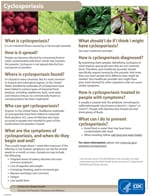Prevention & Control
On the basis of the currently available information, avoiding food or water that may have been contaminated with feces is the best way to prevent cyclosporiasis. Travelers to cyclosporiasis-endemic areas (such as tropical and subtropical regions) should be aware that treatment of water or food by routine chemical disinfection or sanitizing methods is unlikely to kill Cyclospora. No vaccine for cyclosporiasis is available.
Consumers and retailers should always follow safe fruit and vegetable handling recommendations:
Wash: Wash hands with soap and warm water before and after handling or preparing fruits and vegetables. Wash cutting boards, dishes, utensils, and counter tops with soap and hot water between the preparation of raw meat, poultry, and seafood products and the preparation of fruits and vegetables that will not be cooked.
Prepare: Wash all fruits and vegetables thoroughly under running water before eating, cutting, or cooking. Fruits and vegetables that are labeled “prewashed” do not need to be washed again at home. Scrub firm fruits and vegetables, such as melons and cucumbers, with a clean produce brush. Cut away any damaged or bruised areas on fruits and vegetables before preparing and eating.
Store: Refrigerate cut, peeled, or cooked fruits and vegetables as soon as possible, or within 2 hours. Store fruits and vegetables away from raw meat, poultry, and seafood.
The U.S. Food and Drug Administration’s (FDA) Center for Food Safety and Applied Nutrition (CFSAN) publishes detailed food safety recommendations for growers and suppliers. In its Guide to Minimize Microbial Food Safety Hazards for Fresh Fruits and VegetablesExternal
CDC monitors the occurrence of cyclosporiasis in the United States and helps state health departments identify and investigate cyclosporiasis outbreaks to prevent additional cases of illness.
